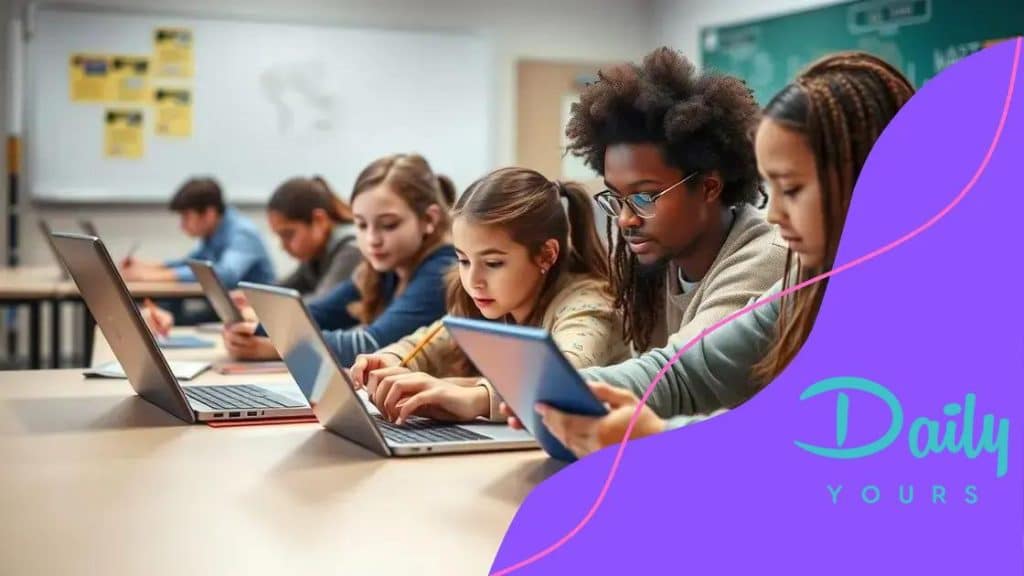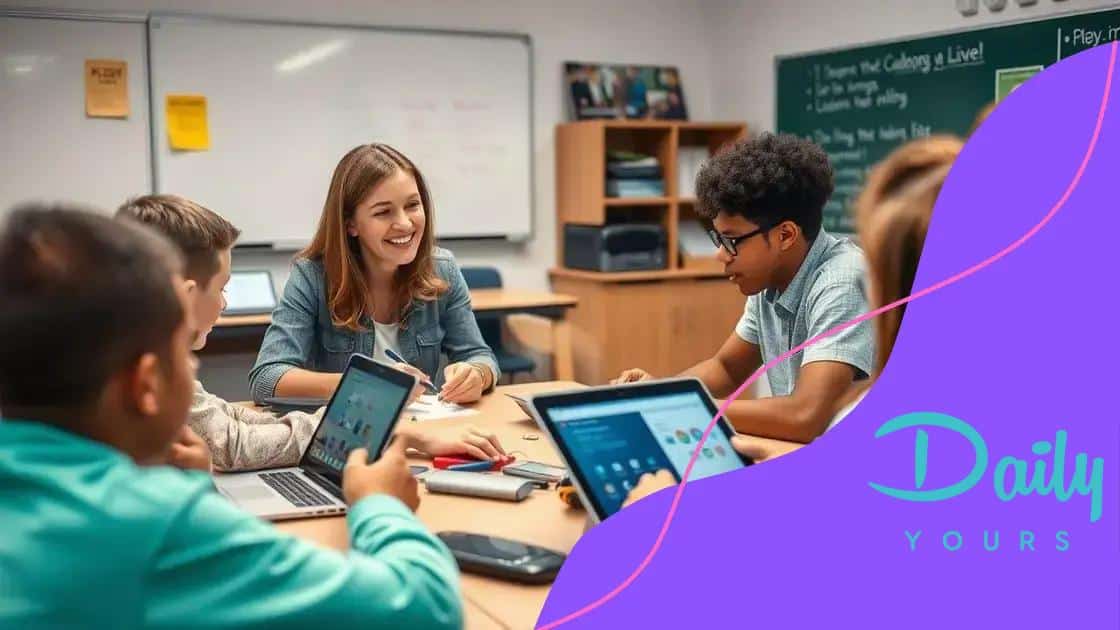Best practices for teaching digital literacy in schools

Anúncios
Assessing digital literacy progress in students involves using formative assessments, performance tasks, and self-assessments to identify strengths and weaknesses, guiding targeted instruction and improving essential digital skills.
Best practices for teaching digital literacy in schools are essential as we navigate an increasingly digital landscape. How can educators ensure students become proficient digital citizens? Let’s explore some effective strategies together.
Anúncios
Understanding digital literacy in the classroom
Understanding digital literacy in the classroom is more important than ever. As technology becomes a vital part of our daily lives, educators must integrate digital skills into their teaching. This approach not only prepares students for the future but also enhances their learning experience.
What is Digital Literacy?
Digital literacy involves the ability to find, evaluate, and use information effectively in a digital environment. It goes beyond basic computer skills. Students must learn how to navigate various digital platforms, understand online safety, and critically assess information sources.
Key Components of Digital Literacy
- Information Evaluation: Students should learn to judge the credibility and reliability of online information.
- Technical Skills: Mastering essential software and applications is crucial for effective digital communication.
- Online Safety: Understanding privacy settings and how to protect personal information is vital in today’s digital world.
As teachers, incorporating these elements in lessons can significantly impact students’ understanding. Frequent discussions about the implications of their digital actions will foster a culture of responsible technology use. This engagement encourages students to express their thoughts critically and respectfully.
Anúncios
Additionally, hands-on activities, such as collaborative projects using technology, help students apply their digital skills in real-world scenarios. By providing opportunities for exploration, teachers can deeply engage students in learning. Integrating digital tools can also facilitate differentiated instruction, meeting the needs of diverse learners.
Strategies for Implementation
- Integrate Technology Across Subjects: Use digital tools in various subjects, enhancing student engagement.
- Promote Active Learning: Encourage students to participate in discussions and group work using technology.
- Assess Progress Regularly: Implement assessments that measure both digital skills and content understanding.
To foster a comprehensive understanding of digital literacy, continuous support and resources for teachers are essential. Training workshops can provide the necessary skills and confidence to educators, allowing them to teach digital literacy effectively. By working together, schools can create a strong foundation that prepares students for the digital age.
Essential skills for students in today’s world
Essential skills for students in today’s world are crucial for their success in a rapidly changing environment. As we embrace technology more each day, it’s necessary for students to develop skills that keep pace with these advancements. Digital literacy is not just about using devices; it encompasses a range of competencies that empower learners.
Critical Thinking and Problem Solving
Students must learn to think critically and solve problems independently. These skills allow them to analyze information rather than just accepting it. Critical thinking encourages students to ask questions, evaluate sources, and develop well-reasoned arguments.
Collaboration and Communication
In a digital world, collaboration and communication skills are also vital. Working effectively in teams, whether in person or online, prepares students for future workplaces. They should be able to share ideas, listen to others, and provide constructive feedback. This ability to collaborate enhances learning and fosters a supportive environment.
- Teamwork: Engaging in group projects helps students build trust and learn from one another.
- Effective Communication: Being able to express thoughts clearly ensures that students can participate actively in discussions.
- Conflict Resolution: Learning how to manage disagreements is crucial for maintaining a positive group dynamic.
Another key skill is adaptability. In today’s fast-paced world, the ability to adjust to new situations is essential. Students should feel encouraged to embrace change and learn from challenges. Being adaptable also means developing a growth mindset, where failures are viewed as opportunities for learning.
Digital Skills
Furthermore, strong digital skills are fundamental. Students need to understand how to navigate technology safely and responsibly. This includes not just knowing how to use software, but also recognizing the importance of online privacy and cybersecurity. Schools should teach students to utilize various tools and applications while fostering a sense of responsibility in their digital interactions.
- Basic Computer Skills: Understanding operating systems and software applications is foundational.
- Research Skills: Knowing how to conduct effective online searches enhances learning.
- Digital Ethics: Students should be aware of appropriate online behavior and the impact of their digital footprint.
Finally, fostering a passion for lifelong learning is vital. Students should be encouraged to pursue knowledge beyond the classroom and develop skills that will serve them throughout their lives. Encouraging curiosity motivates them to explore diverse subjects and adapt to new technologies.
Engaging teaching methods for digital skills

Engaging teaching methods for digital skills are vital in today’s classrooms. As students encounter new technologies, educators need to adopt strategies that foster interest and enhance learning. By using innovative methods, teachers can help students gain the necessary digital competencies.
Interactive Learning Activities
One effective approach is incorporating interactive learning activities. Activities such as coding games or digital scavenger hunts can make learning fun while developing essential skills. These hands-on experiences promote engagement and motivate students to explore new concepts actively.
Project-Based Learning
Project-based learning (PBL) is another powerful method. In a PBL environment, students work on real-world projects that require them to use digital tools. This not only aids in understanding how to apply digital skills but also cultivates problem-solving abilities. For example, students can create a website or a presentation on a relevant topic, integrating research, communication, and technology.
- Collaboration: Working together on projects encourages teamwork and improves communication skills.
- Creativity: Students can express their ideas creatively through digital platforms.
- Critical Thinking: They learn to analyze information and make decisions based on their findings.
Incorporating technology into traditional lessons also helps to engage students. For instance, using videos, online quizzes, or interactive simulations can enhance understanding of complex topics. These tools foster a dynamic learning atmosphere where students feel empowered to participate actively.
Flipped Classroom Model
The flipped classroom model is another engaging approach. In this method, students first access learning materials at home, such as instructional videos, and then come to class to discuss and apply what they’ve learned. This structure encourages students to take responsibility for their learning and allows more time for hands-on practice during classroom sessions.
- Student-Centered Learning: Students have the opportunity to learn at their own pace.
- Effective Use of Class Time: Instructors can focus on application rather than lecturing.
- Encouraging Discussion: Class time can be dedicated to deepening understanding through conversations.
Additionally, teachers can utilize online platforms for collaboration. Tools like Google Classroom or Microsoft Teams offer spaces for students to share resources, work together on assignments, and communicate. This not only assists in developing their digital skills but also prepares them for modern workplace expectations.
Integrating technology into traditional curricula
Integrating technology into traditional curricula is essential for preparing students for the modern world. Incorporating digital tools into everyday lessons enhances engagement and promotes deeper learning. When teachers blend technology with traditional subjects, students can see the real-world applications of their studies.
Enhancing Lessons with Multimedia
One effective way to integrate technology is by using multimedia resources. Videos, podcasts, and interactive presentations can enrich lessons. For example, a history lesson about ancient civilizations can be transformed by including documentary clips or virtual tours of historical sites.
Using Educational Apps
Educational apps also play a crucial role in this integration. These applications can provide personalized learning experiences that cater to individual student needs. Whether it’s practicing math skills through games or developing reading comprehension with interactive stories, apps make learning dynamic and enjoyable.
- Accessibility: Technology makes resources available to all students, ensuring everyone has the tools to learn.
- Instant Feedback: Many apps provide immediate feedback, helping students understand their mistakes and improve.
- Engagement: Using interactive apps keeps students motivated and eager to learn more.
Teachers can also incorporate online collaboration tools in their lessons. Platforms like Google Docs enable students to work together on projects, share ideas, and provide feedback in real time. This fosters a sense of community and teamwork among learners, crucial skills for future workplaces.
Flipped Classrooms
The concept of a flipped classroom further exemplifies how technology can enhance learning. In this approach, students learn new content at home through videos or readings and then come to class to apply that knowledge. This allows teachers to use class time for discussion, hands-on activities, or problem-solving sessions, creating a more interactive learning environment.
- Peer Learning: Students can teach each other, enhancing their understanding through dialogue.
- Focused Class Time: Class time can be dedicated to application rather than lecture.
- Preparation for Independent Learning: Students learn to manage their own study schedules.
Moreover, integrating online assessments can help track students’ progress. Tools like Kahoot! or Quizizz allow teachers to create fun, interactive quizzes that provide insights into student understanding. These assessments can help identify areas where additional support is needed.
As technology continues to evolve, the integration of digital tools into traditional curricula will prepare students for future challenges. By embracing technology, educators can create a richer, more relevant learning experience that develops essential skills for today’s world.
Assessing digital literacy progress in students
Assessing digital literacy progress in students is crucial for understanding their abilities and areas needing improvement. By evaluating these skills, educators can tailor their instruction to better meet student needs. Digital literacy assessment encompasses various methods, each providing valuable insights.
Types of Assessments
One way to assess students’ digital literacy is through formative assessments. These ongoing evaluations occur during the learning process, allowing teachers to monitor progress in real time. Examples include observations during class activities or quizzes related to digital skills.
Performance Tasks
Another effective method is using performance tasks that require students to demonstrate their skills. For instance, students could be asked to create a presentation using digital tools or conduct online research and summarize their findings. These tasks not only assess their technical skills but also their understanding of content.
- Real-World Applications: Tasks should reflect real-world digital literacy requirements, preparing students for future challenges.
- Collaboration: Group projects can assess how well students work together using technology.
- Creativity: Allowing students to express themselves creatively through digital media can provide valuable insights.
In addition to performance tasks, using self-assessments encourages students to reflect on their own digital skills. Providing checklists or rubrics can help them evaluate their proficiency and identify areas for growth. This self-reflection fosters a sense of ownership over their learning journey.
Feedback and Reflection
Constructive feedback is key to the assessment process. Teachers should provide feedback that highlights strengths and suggests specific improvements. Setting aside time for students to reflect on this feedback can empower them to focus on developing their digital skills further.
- Peer Feedback: Involving peers in the feedback process can enhance collaboration and provide diverse perspectives.
- Ongoing Communication: Regular discussions about digital skills can make students feel supported in their learning.
- Goal Setting: Encouraging students to set goals based on their assessments can motivate them to improve.
Finally, it’s important to utilize technology to streamline the assessment process. Online tools can assist teachers in gathering data, tracking progress, and providing timely feedback. By embracing these resources, educators can enhance their ability to assess digital literacy effectively.
FAQ – Questions about Assessing Digital Literacy Progress in Students
Why is assessing digital literacy important?
Assessing digital literacy helps identify students’ strengths and weaknesses, allowing for tailored instruction that supports their growth.
What types of assessments can be used?
Formative assessments, performance tasks, and self-assessments are effective methods for evaluating digital literacy progress.
How can feedback improve digital literacy skills?
Constructive feedback provides students with insights into their performance, guiding them on areas to focus on for improvement.
What role do digital tools play in assessments?
Digital tools streamline the assessment process, making it easier for teachers to track progress and provide timely feedback.





